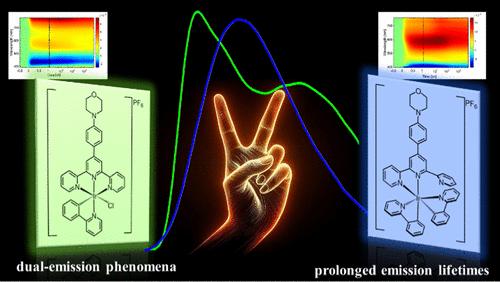附加的Morpholinyl基团对单和双环金属化三吡啶铱(III)发色团光物理行为的影响
IF 4.7
2区 化学
Q1 CHEMISTRY, INORGANIC & NUCLEAR
引用次数: 0
摘要
本文对[IrCl(Ph-py)(morph-C6H4-terpy-κ3N)]PF6 (1A)、[Ir(Ph-py)2(morph-C6H4-terpy-κ2N)]PF6 (2A)、[IrCl(Ph-py)(Ph-terpy-κ3N)]PF6 (1B)和[Ir(Ph-phy)2(Ph-terpy-κ2N)]PF6 (2B),旨在证明通过在 2 的 4′位引入一个远距离电子供能取代基来控制单环和双环金属配合物 [IrCl(Ph-py)(R-C6H4-terpy-κ3N)]PF6 和 [Ir(Ph-py)2(R-C6H4-terpy-κ2N)]PF6 的光物理性质的可能性、2′:6′,2″-叔吡啶(terpy)的 4′位上通过苯基连接体引入的远程电子负载取代基。经证明,吗啉基(morph)的附着会导致具有子午配位 R-C6H4-terpy 配体(κ3N)的单环化 Ir(III)体系的发射特性发生巨大变化。在溶液中,所得到的复合物 [IrCl(Ph-py)(morph-C6H4-terpy-κ3N)]PF6 被发现是双发射型 Ir(III)体系的一个罕见实例。在[Ir(Ph-phy)2(R-C6H4-terpy-κ2N)]PF6 系列中,R-C6H4-terpy 配体以双齿配位模式与中心离子结合,附加的捐电子吗啉基对发射最大值的影响较小,但它被发现是延长激发态寿命的有效工具,并随着溶剂极性的增加而进一步延长。这项研究成果对于更好地理解铱基发光体中的推拉效应和双发射现象,以及开发具有更长发射寿命的发色团具有重要意义。本文章由计算机程序翻译,如有差异,请以英文原文为准。

Effect of the Appended Morpholinyl Group on Photophysical Behavior of Mono- and Bis-cyclometalated Terpyridine Iridium(III) Chromophores
This paper provides extensive studies of [IrCl(Ph-py)(morph-C6H4-terpy-κ3N)]PF6 (1A), [Ir(Ph-py)2(morph-C6H4-terpy-κ2N)]PF6 (2A), [IrCl(Ph-py)(Ph-terpy-κ3N)]PF6 (1B), and [Ir(Ph-py)2(Ph-terpy-κ2N)]PF6 (2B) designed to demonstrate the possibility of controlling the photophysical properties of mono- and bis-cyclometalated complexes [IrCl(Ph-py)(R-C6H4-terpy-κ3N)]PF6 and [Ir(Ph-py)2(R-C6H4-terpy-κ2N)]PF6 through a remote electron-donating substituent introduced into the 4′-position of 2,2′:6′,2″-terpyridine (terpy) via the phenyl linker. The attachment of the morpholinyl (morph) group was evidenced to induce dramatic changes in the emission characteristics of the monocyclometalated Ir(III) systems with meridionally coordinated R-C6H4-terpy ligand (κ3N). In solution, the obtained complex [IrCl(Ph-py)(morph-C6H4-terpy-κ3N)]PF6 was found to be a rare example of dual-emissive Ir(III) systems. Within the series [Ir(Ph-py)2(R-C6H4-terpy-κ2N)]PF6 bearing the R-C6H4-terpy ligand bound to the central ion in a bidentate coordination mode, the appended electron-donating morpholinyl group induced a minor effect on the emission maximum, but it was found to be an effective tool for extending the excited-state lifetime, further prolonging with the increase of solvent polarity. The results of this work are of high significance for better understanding the push–pull effect and dual-emission phenomena in Ir-based luminophores, as well as developing chromophores with prolonged emission lifetimes.
求助全文
通过发布文献求助,成功后即可免费获取论文全文。
去求助
来源期刊

Inorganic Chemistry
化学-无机化学与核化学
CiteScore
7.60
自引率
13.00%
发文量
1960
审稿时长
1.9 months
期刊介绍:
Inorganic Chemistry publishes fundamental studies in all phases of inorganic chemistry. Coverage includes experimental and theoretical reports on quantitative studies of structure and thermodynamics, kinetics, mechanisms of inorganic reactions, bioinorganic chemistry, and relevant aspects of organometallic chemistry, solid-state phenomena, and chemical bonding theory. Emphasis is placed on the synthesis, structure, thermodynamics, reactivity, spectroscopy, and bonding properties of significant new and known compounds.
 求助内容:
求助内容: 应助结果提醒方式:
应助结果提醒方式:


